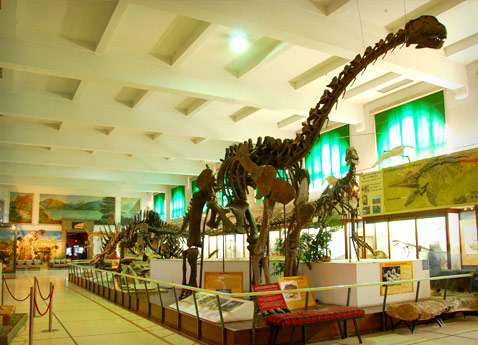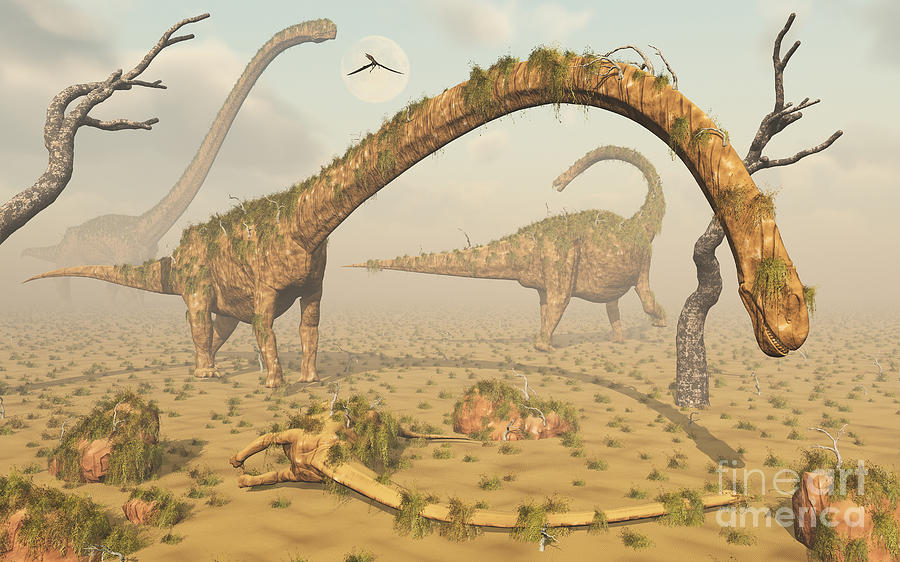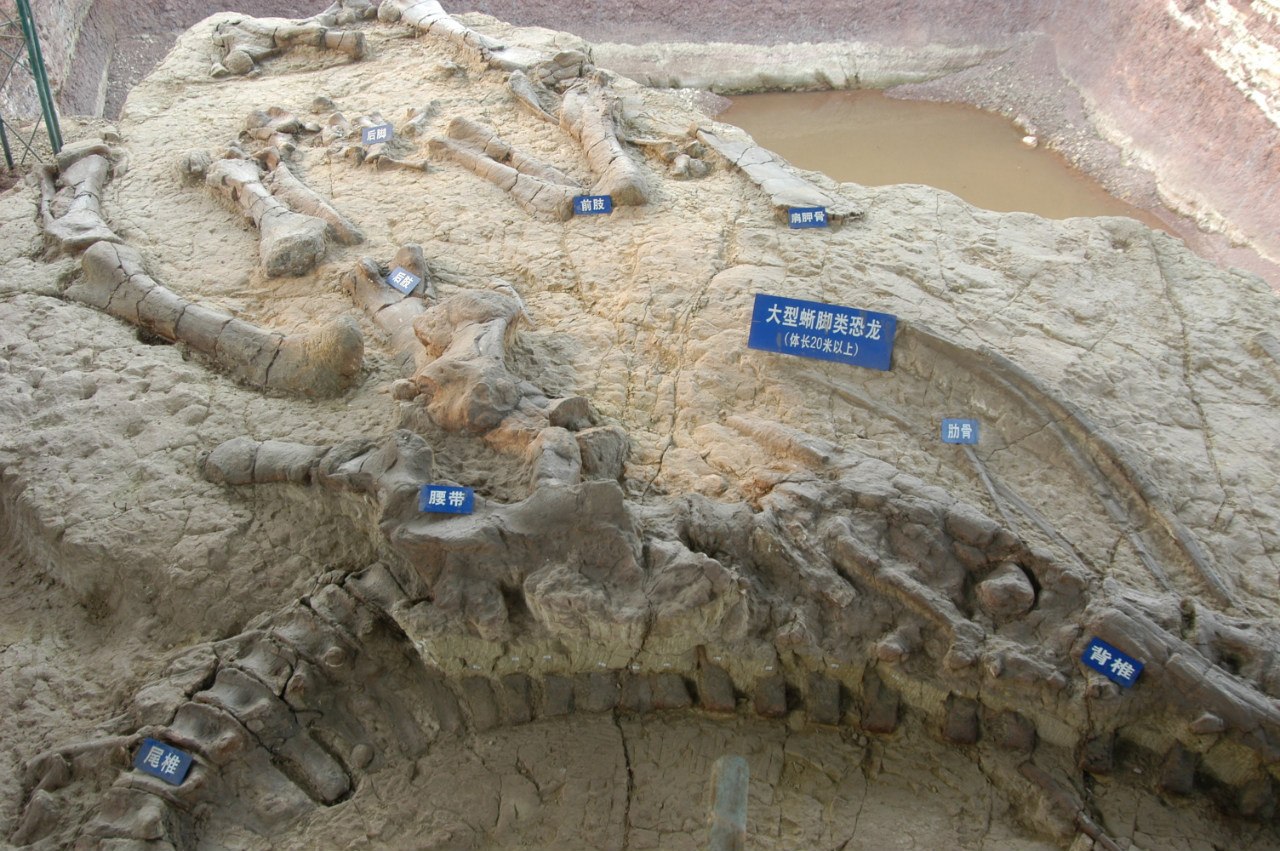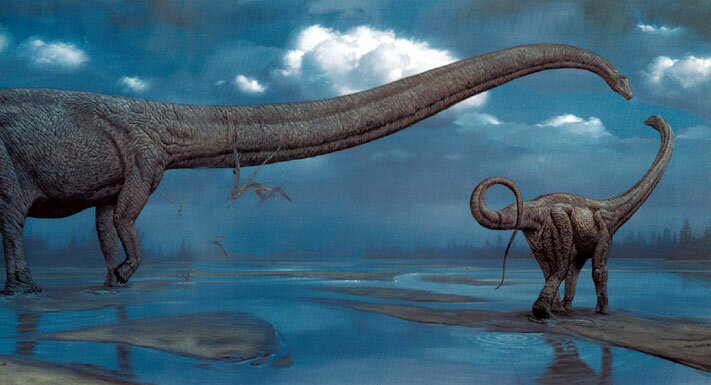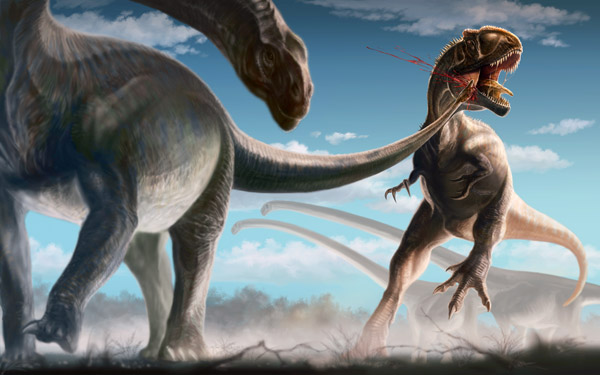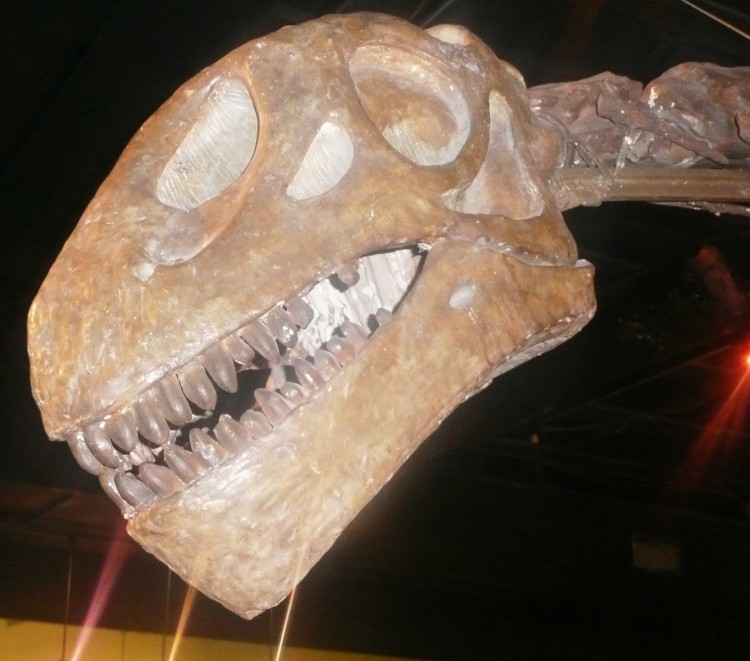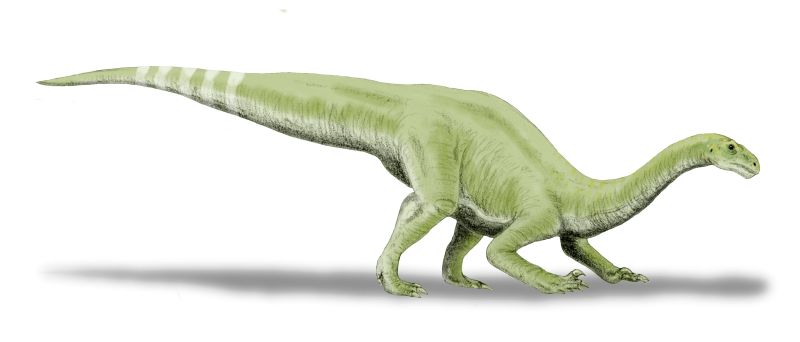[Recent Entries][Archive][Friends][User Info]
Below are the 20 most recent journal entries recorded in the "Сообщество, посвящённое ра" journal:| February 11th, 2016 | |||||||||||||||||||||||||||||||||||||||||
|---|---|---|---|---|---|---|---|---|---|---|---|---|---|---|---|---|---|---|---|---|---|---|---|---|---|---|---|---|---|---|---|---|---|---|---|---|---|---|---|---|---|
| 11:06 pm [industrialterro] [Link] |
Ampelosaurus Ampelosaurus (/ˌæmpᵻloʊˈsɔːrəs/ am-pi-lo-sawr-əs; meaning "vine lizard") is a titanosaurian sauropod dinosaur hailing from the Late Cretaceous Period of what is now Europe. Its type species is A. atacis, named by Le Loeuff in 1995. A possible unnamed species has givenAmpelosaurus an age reaching to the latest Cretaceous, from about 70 to 66 million years ago. Like most sauropods, it would have had a long neck and tail but it also carried armor in the form of osteoderms. Over 500 bones have been assigned to Ampelosaurus and all but the braincase (assigned to A. sp.) has been assigned to A. atacis. They are assigned to the same species because all the differences in the limb proportions have been linked to individual variation. A. atacis is known from a few, well-preserved teeth and some cranial material. A right scapula was discovered associated with a coracoid. The blade of the scapula, contrary to most titanosaurs, is triangular. The blade narrows at one end instead of showing an expansion like most other genera. A. atacis is also known from a pubis about 75 centimetres (30 in) long and an ilium. Aside from that, it is known from a partial forelimb, and many femora. Titanosaurians were a flourishing group of sauropod dinosaurs during Cretaceous times. The Spanish locality from the latest Cretaceous of “Lo Hueco” yielded a relatively well preserved, titanosaurian braincase, which shares a number of unique features with A. atacis from France. However, it appeared to differ from A. atacis in some traits also. The specimen has been provisionally identified as Ampelosaurus sp.. A. sp. is most likely a mature titanosaurian since the bones of the braincase have largely fused together. Ampelosaurus lived alongside many other animals. Over 8500 specimens have been found alongside it, including gastropods, bivalves, crocodiles, other sauropods, plants and invertebrates in the Villalba de la Sierra, Gres de Saint-Chinian, Marnes Rouges Inférieures and Gres de Labarre formations. Recent attention has made Ampelosaurus one of the most well-known dinosaurs known from France. Like most sauropods, Ampelosaurus would have had a long neck and tail, but it also carried armor in the form of osteoderms 25 to 28 centimetres (9.8 to 11.0 in) long. The four osteoderms found have three different morphologies, they are plate, bulb, and spine-shaped. This dinosaur would have stretched up to about 15 metres (49 ft) from snout to tail. Ampelosaurus atacis is known from many unattached bones and teeth. It is one of the best-known dinosaurs from France. It is considered to be a dwarf sauropod by Coria et al. (2005) because it has a smaller size in comparison with its ancestors. Ampelosaurus is one of the most completely known titanosaurian sauropod from Europe. Since 1989, over 500 bones discovered at the Upper Cretaceous Bellevue locality of southern France have been assigned to A. atacis. An abundant amount of well-preserved elements have been uncovered at Bellevue. In the original description, only a tooth and some vertebrae were examined. In 2005, a complete description was made by Le Loueff of all known material, allowing Ampelosaurus to be much better understood. All the material has been assigned to the species, and even though there are some differences in limb proportions, it has all been linked to individual variation. A. atacis is known from a few, well-preserved teeth and some cranial material, a tooth of which was described in its original description. The teeth differentiate Ampelosaurus from Magyarosaurus and Lirainosaurus, both of which are also from Europe. The teeth are different from the two later genera as Ampelosaurus has teeth that are roughly cylindrical in the top with thin expansions at the bottom. They are 21 millimetres (0.83 in) high and about 6 millimetres (0.24 in) wide. Those expansions give its teeth a slight constriction between the root and the crown. The teeth are also quite different from the peg-like teeth of titanosaurids. The teeth, have a general morphology similar to titanosauriansAntarctosaurus and a braincase from Dongargaon. Another skull was described from southern France, but showed some differences, meaning there could have been at least two different titanosaurians in France during the Late Cretaceous. The scapula was found attached to a coracoid. In the longer direction, the bone is 72 centimetres (28 in) long. The blade of the scapula, contrary to titanosaurs, is triangular, larger closer to the base. The blade narrows distally instead of showing an expansion. Differing fromMagyarosaurus and Saltasaurus, the scapula does not have the dorsal crest at the base of the scapular blade. The shape of the coracoid is quadrangular, and the coracoid has a thickened cranial margin. Ampelosaurus is also known from a pubis, about 75 centimetres (30 in) long. It has a strong distal expansion, that is similar to a titanosaur from Brazil, and a large foramen. Contrary to the South American titanosaurs, the ilium does not have an expansion on the side. The ischium, known from a shaft, is unexpanded distally and very well developed. It is also very flat. An incomplete radius is also known. It lacks the proximal and distal ends, and possesses a very prominent ridge along it. The largest and best-preserved specimens are both ulnas. The right ulna has a total length of 395 millimetres (15.6 in). The right ulna is small and slender, is missing an olecranon, and has a well-marked ridge. The left ulna is larger, with a length of 725 millimetres (28.5 in). The ulna has a deep radial fossa. About 27 femora are known from Bellevue, making them the most common bone, most of them more-or-less complete. They are very flat craniocaudally but otherwise, lack any unusual features. In a study of its bone physiology, it was found that the maximum known femur length was 1,100 millimetres (43 in), which is much larger than previously known (802 millimetres (31.6 in)). That means, that the ancestorsAmpelosaurus were slightly smaller than itself. 18 humeri are also known, but none of them approach the size of the largest femur. The humeri do not have a free medullary cavity. The humeri are robust, about 63 centimetres (25 in) long, with very expanded distal and proximal ends. Three different types of osteoderms have been recovered at Bellevue. Two with large spines have been uncovered. At the base of each spine, which is about 12 centimetres (4.7 in) tall, are two large foramina. The internal faces are all concavo-convex and have a ridge opposite the spine. In side view, they have two sections, a low half that progressively thickens, and a spine. ( Read More ) Размеры тела в сравнении с человеком: Ископаемые останки и реплики (1, 2, 3, 4, 5, 6, 7, 8): ( Read More ) Tags: Вымершие рептилии, Мел, авеметатарзалии, архозавроморфы, архозавры, диапсиды, динозавроморфы, динозавры, завроподоморфы, завроподы, макронары, титанозавроформы, титанозавры, ящеротазовые | ||||||||||||||||||||||||||||||||||||||||
| June 25th, 2015 | |||||||||||||||||||||||||||||||||||||||||
| 05:08 pm [industrialterro] [Link] |
Amazonsaurus Amazonsaurus (/ˌæməzənˈsɔrəs/ AM-ə-zən-SAWR-əs, "Amazon lizard") is a genus of diplodocoid sauropod dinosaur from the Early Cretaceous Period of what is now South America. It would have been a large-bodied quadrupedal herbivore with a long neck and whiplash tail. Although more derived diplodocoids were some of the longest animals ever to exist, Amazonsaurus was probably not more than 12 meters (40 ft) long. Despite the fact that other dinosaurs have been found in Brazil, this is the first named genus from territory in the Amazon Basin. The generic name is derived from the Brazilian Legal Amazon region and the Greek word sauros ("lizard"). There is one named species, (A. maranhensis), which is named after the Brazilian state of Maranhão. Both genus and species were named in 2003 by Brazilian paleontologists Ismar de Souza Carvalho and Leonardo dos Santos Avilla, and their Argentine colleague, Leonardo Salgado. Fossils of Amazonsaurus, including some back and tail vertebrae, ribs, and fragments of the pelvis, are the only dinosaur remains identifiable at the generic level from the Itapecuru Formation of Maranhão. This geologic formation dates back to the Aptian through Albian epochs of the Early Cretaceous Period, or about 125 to 100 million years ago. Amazonsaurus was recovered in sediments which are interpreted by geologists as floodplain deposits near a river delta. The tall neural spines on the tail vertebrae identify Amazonsaurus as a diplodocoid sauropod, but the fragmentary nature of the only known specimen makes it difficult to place A. maranhensis more specifically within the superfamily Diplodocoidea. However, some features of these vertebrae suggest it may be a late-surviving member of a line of basal diplodocoids. At least one published cladistic analysis shows Amazonsaurus to be more derived than rebbachisaurids, but basal to dicraeosaurids and diplodocids within Diplodocoidea (Salgado et al., 2004). Basal diplodocoids are found in several parts of South America, as well as northern Africa, during the Early Cretaceous, as are titanosaurian sauropods, and the carcharodontosaurid and spinosaurid theropods. By the Late Cretaceous Period, the diplodocoids had gone extinct, while titanosaurs proliferated. The predatory theropod families of the Early Cretaceous were also replaced by abelisaurid theropods throughout the southern continents during the Late Cretaceous. Rebbachisauridae — семейство завроподовых динозавров из надсемейства Diplodocoidea, известных из фрагментарных останков мелового периода Южной Америки, Африки и Европы. Данная группа являются довольно плохо изученной среди завроподов. Типовой род семейства Rebbachisaurus, гигантский завропод найденный в Северной Африки, впервые был описан в 1954 году. С тех пор было описано несколько тесно связанных видов, в основном из Южной Америки. В 1990 году палеонтолог Джек Макинтош включил род Rebbachisaurus в семейство Diplodocidae, подсемейства Dicraeosaurinae на основе описанных останков скелета. С открытием в последующие годы дополнительных видов, стало ясно, что Rebbachisauridae составляют отдельную группу динозавров, а в 1997 году аргентинский палеонтологом Хосе Бонапарте было назначено новое семейство — Rebbachisauridae. Пол Серено и его сотрудники в 1999 году перегруппировали данное семейство. Несмотря на то, что представители семейства известны только из меловых отложений, они вероятно являются базальными членами надсемейства Diplodocoidea и, следовательно, более примитивны, чем ранние диплодоки и апатозавр, жившие в конце юрского периода, что указывает на большой пробел в эволюционном древе завропод от средней до поздней юры. Кроме Rebbachisaurus и Limaysaurus в семейство относят вид Nigersaurus taqueti, известный по нескольким хорошо сохранившимся скелетам из раннего мела (апт — альб) Нигера. Из десятка видов семейства до сих пор только Limaysaurus и Nigersaurus известны по относительно полным скелетам. Все другие останки очень фрагментарны, так что трудно получить полную картину для данного семейства. Одним из характерных общих признаков этой клады является своеобразная форма лопатки. Кроме Африки и Южной Америки Rebbachisauridae также обитали в Европе. Вид Histriasaurus boscarottii был описан на основе нескольких позвонков из раннего мела (готерив — баррем) Хорватии (Dalla Vecchia, 1998) и является самый ранним динозавром из этого семейства. Фрагменты костей из формации Кастрильо-де-ла-Рейна (баррем — апт) Испании в 2011 году были подробно описаны под именем Demandasaurus darwini. Также известны останки на острове Уайт в Англии. Фрагменты скелета (кость лопатки), найденные Ником Касе в 1989 году в формации Уэссекс на юго-западном побережье острова Уайт, были описаны Филипом Маннионом в 2009 году. В кладистическом анализе, проведённом Карбаллидо в соавторстве с другими учеными в 2010 году, полученные на основе сравнения лопаточных костей данные указывают на очень тесные связи английских реббахизаврид с южноамериканскими видами, что может свидетельствовать о том, что английский реббахизаврид может являться сестринским таксоном для южноамериканского вида Limaysausus tessonei. Вполне возможно, что описанный в 2011 году хвостовой позвонок принадлежат животному того же вида, несмотря на то что данные филогенетического анализа установили родство этого динозавра с испанским Demandasaurus и африканским Nigersaurus, а не с Limaysaurus. д Размеры тела в сравнении с человеком: Tags: Вымершие рептилии, Мел, авеметатарзалии, архозавроморфы, архозавры, диапсиды, динозавроморфы, динозавры, диплодоциды, завроподоморфы, завроподы, реббахизавриды, ящеротазовые | ||||||||||||||||||||||||||||||||||||||||
| June 21st, 2015 | |||||||||||||||||||||||||||||||||||||||||
| 08:13 pm [industrialterro] [Link] |
Amargasaurus Амаргаза́вр (Amargasaurus, букв. «ящер из каньона Ла-Амарга») — род динозавров, живших в Аргентине 130 млн лет назад. Название «амаргазавр» происходит от названия каньона (Ла-Амарга), где были найдены останки. Амаргазавр описан и назван Хосе Бонапарте в 1991 году. Точная длина неизвестна, так как хвост не был найден, однако она равнялась приблизительно 9-12 м (по некоторым источникам 14 м), высота — 3-3,7 м, вес — до 9000 кг. Отличительные черты этого вида: слегка выступающие из челюсти зубы и два ряда 65-сантиметровых шипов на верхней стороне тела. Согласно одной из теорий, шипы были покрыты роговой тканью и предназначались для защиты от хищников, а если верить другой теории, то у амаргазавра был некий парус, пронизанный кровеносными сосудами, как у спинозавра. Учитывая, то, что эта конструкция значительно ограничивала подвижность шеи амаргазавра нельзя сказать, что у ящера был парус; у динозавра не хватило бы сил, чтобы поднять всё это, да к тому же не смог бы поворачивать голову, однако у шипов были и плюсы; они помогали в брачных играх и защите от хищников. Научно описаны два вида амаргазавра: A. cazaui и A. groeben. Ареал амаргазавра ограничен территорией нынешней провинции Неукен (Аргентина). В Аргентине с готеривского по аптский отделы мелового периода с амаргoзавром обитали абелизаврид лигабуейно и завропод агустиния. Растительность тоже не отличалась разнообразием: в первую очередь это древовидные папоротники и хвойные (араукарии и сосны). Амаргазавр, по-видимому, питался араукариями и древовидными папоротниками.
Этот динозавр рос сравнительно медленно для зауропода.
Amargasaurus (/əˌmɑrɡəˈsɔrəs/; "La Amarga lizard") is a genus of dicraeosaurid sauropod dinosaur from the Early Cretaceous Period (129.4–122.46 mya) of what is now South America. It was small for a sauropod, reaching 10 meters (33 feet) length. It would have been a quadrupedal herbivore with a long, low skull on the end of a long neck, much like its relative Dicraeosaurus. However, this dinosaur sported two parallel rows of tall spines down its neck and back, taller than in any other known sauropod. These spines have been reconstructed supporting skin sails, but the "skin sail" hypothesis was rejected by Gregory S. Paul in 2000. It was found at the La Amarga Arroyo (which means "the bitter creek" in Spanish) in Neuquén Province, Argentina. They are related to Diplodocus, a giant, long-necked sauropod from the Late Jurassic of North America. However they went down a different evolutionary path to their ancestors and evolved a much shorter neck and a drastically reduced overall body size. Amargasaurus was small for a sauropod, measuring 9 to 10 meters in length and weighing approximately 2.6 tons. It moved on four legs and probably was unable to rear on its hind legs. The neck of Amargasaurus, measuring 2.4 meters in length, was proportionally short for sauropod standards. It consisted of 13 cervical vertebrae which were opisthocoelous (convex at the front and hollow at the back), forming ball-and-socket joints with neighbouring vertebrae. The trunk was made out of 9 dorsal and probably 5 fused sacral vertebrae. While the foremost dorsals were opisthocoelous, the remaining dorsals were amphyplatyan (flat on both ends). Robust transverse processes (lateral projections connecting to the ribs) indicate a strong developed rib cage. The dorsal vertebrae of Amargasaurus and other dicraeosaurids lack pleurocoels, the deep lateral excavations that were characteristic for other sauropods. The most obvious feature of the Amargasaurus' skeleton were the extremely tall, upwardly projecting neural spines on the neck and foremost back vertebrae. The neural spines were bifurcated along their entire length, forming a double row. They were circular in cross section and tapered towards their tips. The tallest spines could be found on the middle part of the neck, where they reached 60 cm on the 8th cervical. On the neck, they were bowed backwards, projecting above the adjacent vertebra. Greatly elongated spines continue along the last two dorsal vertebrae, the hip and foremost tail. However, in these regions the spines were not bifurcated but flared into a paddle-shaped upper end. The skull is only incompletely preserved––however, it likely had a horselike, broad snout equipped with pencil-like teeth, based on related sauropods for which more complete skulls are known. As in other dicraeosaurids, the external nares (nostril openings) were situated in the posterior half of the skull, diagonally above the eye sockets, which were proportionally large. Additional (fenestrae) could be found surrounding the eye sockets: The infratemporal fenestrae, located below the eye sockets, were long and narrow. Behind the eye sockets were the supratemporal feneatrae, which, in dicraeosaurids, were uniquely small and directed laterally (in contrast to other diapsids, where they were directed upwards). In front of the eyes would have been the antorbital fenestra, although this region is not preserved. Small openings, called parietal openings or fontanelles, can be seen on the backside of the skull. In other tetrapods, these openings are usually seen only in juveniles and they close as the individual grows. The name Amargasaurus was coined in 1991 by Argentine paleontologists Leonardo Salgado and José Bonaparte, because its fossil remains were found alongside the La Amarga Arroyo in the province of Neuquén in Argentina. La Amarga is also the name of a nearby town, as well as the geologic formation the remains were recovered from. The word amarga itself is Spanish for "bitter," while sauros is Greek for "lizard." The one named species (A. cazaui) is named in honor of the man who discovered the site, Luis Cazau, a geologist with the YPF oil company, which at the time was state-owned. This site is located in the lower (older) sections of the La Amarga Formation, which dates to the Barremian through early Aptian stages of the Early Cretaceous Period, or around 130 to 120 million years ago. Amargasaurus is known from a relatively complete skeleton from a single individual. This skeleton includes the back of the skull, and all vertebrae of the neck, back, and hips, as well as a bit of the tail. The right side of the shoulder girdle is also known, as are the left forelimb and hind limb, and the left ilium, a bone of the pelvis. The spines may have supported a pair of tall skin sails. Similar sails are seen in the unrelated dinosaurs Spinosaurus and Ouranosaurus, as well as the pelycosaurs Dimetrodon and Edaphosaurus. There are a variety of hypotheses for the function of these sails, including defense, communication (for mating purposes or for simple species recognition), or temperature regulation. Gregory Paul argued that parallel neck sails would have reduced neck flexion. Instead, he proposed that, with their circular rather than flat cross-sections, these spines were more likely covered with a horny sheath. He even suggests that they could have been clattered together for a sound display. Similar spines are found on the presacral vertebrae of Dicraeosaurus from Africa, although not nearly as tall. Amargasaurus and Dicraeosaurus are united with the more recently discovered Brachytrachelopan in the family Dicraeosauridae. Dicraeosaurids and diplodocid sauropods are included in a group called Flagellicaudata.
Амаргазавр - завропод раннего мелового периода был не очень крупным динозавром. В длину динозавр достигал всего десять метров и был гораздо короче своих гигантских родственников. Эта растительноядная рептилия была ростом до двух метров и весом до пяти тонн. Замечательной и главной особенностью амаргазавра являлись шипы длиной до шестидесяти пяти сантиметров, располагавшиеся на шее, спине и хвосте. Одного ряда шипов было бы вполне достаточно, чтобы динозавр имел странный вид, но двойной ряд - это просто ошеломляющее зрелище! Ряды шипов могли составлять особую гриву, а могли быть покрыты кожей и представлять собой подобие двойного паруса (гребня). Палеонтологи долгие годы спорили о том, какую же функцию могли выполнять эти шипы. Они расположены не слишком удобно, чтобы служить защитой от хищников, хотя не исключено, что амаргазавр мог ими отпугивать хищников, ведь удлиненные шипы были покрыты роговой оболочкой, и он выглядел со стороны как гигантский дикобраз. Может быть, они служили, чтобы животное казалось больше, чем есть на самом деле? Или этот гребень мог быть каркасом для своего рода паруса, выполнявшего роль терморегулятора в теле? Или же этот подарок эволюции играл особую роль в социальной жизни животного, помогал узнавать друг друга, добиваться определенного статуса в стаде и служить для брачных ритуалов? А может это был своеобразный горб, как у современного верблюда? Много вопросов, много теорий и предположений, но пока ученые не могут дать однозначного ответа, и роль шипов в жизни амаргазавра до сих пор остается под завесой тайны. До конца неясно, какую они могли также принимать форму, но, несомненно, это было очень нужное и уникальное приспособление. В любом случае эти шипы были хорошим преимуществом для ящера, который был практически вдвое короче своих сородичей. Дополнительные конструкции вроде этой побуждают ученых искать новые пути в палеонтологии. Такое впечатление, что эволюция берет простые и понятные части динозавров имеющих очевидные функции и наделяет их озадачивающими дополнениями, назначение которых загадочно и зачастую противоречиво. Шипастым позвоночником амаргазавр напоминал другого ящера – африканского зауропода дикреозавра (Dicraeosaurus) и поэтому некоторые палеонтологи выделяют эти два вида в особое семейство Dicraeosauridae. Палеонтологи связывают этих животных из-за наличия у них схожих шипов на пресакральных и ретросакральных позвонках, хотя у Dicraeosaurus эти шипы по высоте значительно ниже. Палеонтолог Грегори Пол утверждал, что двойной парус (шипы, гребень) имел свои недостатки: он ограничивали шею в движениях, уменьшая ее сгибание. Ученый даже предполагал, что амаргазавр мог стучать шипами друг о друга, издавая звуки при встрече. Шея амаргазавра состояла из тринадцати позвонков, которые были выпуклыми спереди и полыми сзади, образуя шаровое соединение (типа шарниров) с соседними позвонками. Шея образовывала сильную дугу, с очень высокой поднятой средней частью, и головой, как правило, всегда опущенной к самой земле. У амаргазавра была маленькая голова с длинным и низким черепом, у которого была суженная верхушка. Широкая выдающаяся вперед морда была оснащена тупыми карандашеподобными зубами, напоминавшими колышки. Такие зубы были отличным приспособлением для обрывания и перемалывания растительности. Как и у других дикреозаврид, внешние ноздри (отверстия ноздри) были расположены в задней половине черепа, по диагонали над глазницами, которые были пропорционально большими. Подвисочные отверстия, расположенные ниже глазниц, были длинные и узкие. За глазницами были надвисочные отверстия, которые у дикреозаврид были маленького размера и направлены в стороны (в отличие от других диапсидных рептилий, у которых они были направлены вверх). В передней части глаза были подглазничные отверстия, хотя эта область не сохранилась. Малые отверстия, называемые теменными отверстиями или родничками, располагались на задней стороне черепа. У других тетрапод эти отверстия обычно наблюдаются только у молодых особей, и они закрываются по мере роста. Амаргазавр передвигался на четырех мощных конечностях. Передние конечности были более короткими, чем задние. На всех его колоннообразных ногах было по пять пальцев. Один из пальцев на каждой из конечностей имел коготь, возможно использовавшийся для защиты. Как предполагают ученые, возможно, амаргазавры могли вставать на задние лапы, чтобы обрывать листву с верхушек деревьев или отпугивать врагов. Также для защиты динозавр использовал свой тонкий хлыстообразный хвост. В остальном же этот завропод мало отличался от своих сородичей.
Репродукции (1, 2, 3, 4, 5, 6, 7, 8, 9, 10): ( Read More ) Сравнение размеров тела с человеком и другими дикреозавридами: Tags: Вымершие рептилии, Мел, авеметатарзалии, архозавроморфы, архозавры, диапсиды, дикреозавры, динозавроморфы, динозавры, завроподоморфы, завроподы, ящеротазовые | ||||||||||||||||||||||||||||||||||||||||
| March 24th, 2015 | |||||||||||||||||||||||||||||||||||||||||
| 04:37 pm [industrialterro] [Link] |
Alamosaurus Аламозавр (Alamosaurus) — род ящеротазовых динозавров инфраотряда завропод. Включает один вид — Alamosaurus sanjuanensis. Эти ящеры жили в верхнем мелу (около 70—65 млн лет назад) на территории Северной Америки. Они достигали длины 21 м и веса 30 тонн. У аламозавра, как и у других завропод, была длинная шея и не менее длинный хвост, заканчивающийся кнутоподобным сужением. Вопреки популярному утверждению, этот динозавр не был назван в честь миссии Аламо в Техасе или произошедшей там в 1836 году битвы. Голотип этого вида был обнаружен в Нью-Мексико, и только после этого другие экземпляры были найдены и в Техасе. Родовое название дано по имени геологической свиты Ojo Alamo, в породах которой нашли первый экземпляр, а видовое — по имени округа Сан-Хуан штата Нью-Мексико, где была сделана эта находка. Аламозавра уверенно относят к группе титанозавров, в пределах которой он считается продвинутым родом. Но его родственные связи в пределах этой группы остаются неясными. Некоторые авторы включают его вместе с родом Opisthocoelicaudia в подсемейство Opisthocoelicaudinae семейства Saltasauridae. Согласно другим исследованиям, аламозавр — сестринская группа рода Pellegrinisaurus, и в состав Saltasauridae они не входят. Некоторые учёные отмечают сходство аламозавра с Neuquensaurus и Trigonosaurus. Alamosaurus (meaning "Ojo Alamo lizard") is a genus of titanosaurian sauropod dinosaurs, containing a single species, Alamosaurus sanjuanensis, from the late Cretaceous Period of what is now southern North America. It was a large quadrupedal herbivore. Isolated vertebrae and limb bones indicate that it reached sizes comparable to Argentinosaurus and Puertasaurus, which would make it the largest dinosaur known from North America. Its fossils have been recovered from a variety of geological formations spanning the Maastrichtian stage (late Edmontonian-Lancian land vertebrate ages) of the Late Cretaceous. Specimens of a juvenile Alamosaurus sanjuanensis have been recovered from only a few meters below the Cretaceous-Paleogene boundary in Texas, making it among the last surviving non-avian dinosaur species. The vertebrae from the middle part of its tail had elongated centra. Alamosaurus had vertebral lateral fossae that resembled shallow depressions. Fossae that similarly resemble shallow depressions are known from Saltasaurus, Malawisaurus, Aeolosaurus, and Gondwanatitan. Venenosaurus also had depression-like fossae, but its "depressions" penetrated deeper into the vertebrae, were divided into two chambers, and extend farther into the vertebral columns. Alamosaurus had more robust radii than Venenosaurus. Long thought to have been unarmored, recent discoveries indicate that Alamosaurus was armored like other lithostrotians, including Saltasaurus. Alamosaurus remains have been discovered throughout the southwestern United States. The holotype was discovered in the Naashoibito Member of the Ojo Alamo Formation (or Kirtland Formation under a different definition) of New Mexico which was deposited during the Maastrichtian stage of the Late Cretaceous Period. Bones have also been recovered from other Maastrichtian formations, like the North Horn Formation of Utah and the Black Peaks, El Picacho and Javelina Formations of Texas. Gilmore originally described a scapula (shoulder bone) and ischium (pelvic bone) in 1922. In 1946, he found a more complete specimen in Utah, consisting of a complete tail, a right forelimb complete except for the tips of the toes, and both ischia. Since then, many other bits and pieces from Texas, New Mexico, and Utah have been referred to Alamosaurus, often without much description. The most completely known specimen is a recently discovered juvenile skeleton from Texas, which allowed educated estimates of length and mass. One specimen of Alamosaurus, "USNM 15660", was first uncovered in 1937. Although originally found by Gilmore, it was first recognized by Michael Brett-Surman. It has been catalogued under the same number as a more complete and well-known specimen of Alamosaurus, which was found in very close proximity based on bone impressions. In 2015 it was realized that the specimen, which had been previously described, also included osteoderms, the first confirmation they existed on Alamosaurus. No skull material is known, except for a few slender teeth. Contrary to popular assertions, this dinosaur is not named after the Alamo in San Antonio, Texas, or the battle that was fought there. The holotype, or original specimen, was discovered in New Mexico and, at the time of its naming, Alamosaurus had not yet been found in Texas. Instead, the name Alamosaurus comes from Ojo Alamo, the geologic formation in which it was found and which was, in turn, named after the nearby Ojo Alamo trading post (since this time there has been some debate as to whether to reclassify the Alamosaurus-bearing rocks as belonging to the Kirtland Formation or whether they should remain in the Ojo Alamo Formation). The term alamo itself is a Spanish word meaning "poplar" and is used for the local subspecies of cottonwood tree. The term saurus is derived from saura (σαυρα), Greek for "lizard" and is the most common suffix used in dinosaur names. There is one species (A. sanjuanensis), which is named after San Juan County, New Mexico, where the first remains were found. Both genus and species were named by Smithsonian paleontologist Charles W. Gilmore in 1922. Alamosaurus fossils are most notably found in the Naashoibito member of the Ojo Alamo Formation (dated to between about 69-68 million years old) and in the Javelina Formation, though the exact age range of the later has been difficult to determine. A juvenile specimen of Alamosaurus has been reported to come from the Black Peaks Formation, which overlies the Javelina in Big Bend, Texas, and which straddles the Cretaceous-Paleogene boundary. The Alamosaurus specimen was reported to come from a few meters below the boundary, dated to 66 Ma ago, though the position of the boundary in this region is uncertain. Only one geological site in the Javelina Formation has thus far yielded the correct rock types for radiometric dating. The outcrop, situated in the middle strata of the formation about 90 meters below the K-Pg boundary and within the local range of Alamosaurus fossils, was dated to 69.0 plus or minus 0.9 million years old in 2010. Using this date, in correlation with a measured age from the underlying Aguja Formation and the likely location of the K-Pg boundary in the overlying Black Peaks Formation, the Alamosaurus fauna seems to have lasted from about 70-66 million years ago, with the earliest records of Alamosaurus near the base of the Javelina formation, and the latest just below the K-Pg boundary in the Black Peaks Formation. Skeletal elements of Alamosaurus are among the most common Late Cretaceous dinosaur fossils found in the United States Southwest and are now used to define the fauna of that time and place. In the south of Late Cretaceous North America, the transition from the Edmontonian to the Lancian is even more dramatic than it was in the north. Thomas M. Lehman describes it as "the abrupt reemergence of a fauna with a superficially 'Jurassic' aspect." These faunas are dominated by Alamosaurus and feature abundant Quetzalcoatlus in Texas. The Alamosaurus-Quetzalcoatlus association probably represent semi-arid inland plains. The appearance of Alamosaurus may have represented an immigration event from South America. Some taxa may have co-occurred on both continents, including Kritosaurus and Avisaurus. Alamosaurus appears and achieves dominance in its environment very abruptly, which might support the idea that it originated following an immigration event. Other scientists speculated that Alamosaurus was an immigrant from Asia. However, critics of the immigration hypothesis note that inhabitants of an upland environment like Alamosaurus are more likely to be endemic than coastal species, and tend to have less of an ability to cross bodies of water. Further, Early Cretaceous titanosaurs are already known, so North American potential ancestors for Alamosaurus already existed. Other contemporaneous dinosaurs from that part of the world include tyrannosaurs, smaller theropods, the hadrosaurs Edmontosaurus sp. and Kritosaurus sp., the ankylosaur Glyptodontopelta, and the ceratopsids Torosaurus utahensis and Ojoceratops fowleri.
Размеры тела в сравнении с человеком:
Ископаемые останки и реплики (1, 2, 3, 4):
Tags: Вымершие рептилии, Мел, авеметатарзалии, архозавроморфы, архозавры, диапсиды, динозавроморфы, динозавры, завроподоморфы, завроподы, макронары, титанозавроформы, титанозавры, ящеротазовые | ||||||||||||||||||||||||||||||||||||||||
| March 1st, 2015 | |||||||||||||||||||||||||||||||||||||||||
| 06:57 pm [industrialterro] [Link] |
Agustinia Агустиния (Agustinia ligabuei) — вид ящеротазовых динозавров монотипного рода Agustinia из группы зауроподоморфов, живших в раннем меловом периоде (около 116—100 миллионов лет назад), на территории нынешней Южной Америки. Окаменелости были найдены в провинции Неукен (формация Lohan Cura) в Аргентине. Впервые описан палеонтологом Бонапарте в 1999 году. The name Agustinia honors the discoverer of the specimen, Agustin Martinelli. This dinosaur was originally named in a 1998 abstract written by famous Argentine paleontologist Jose Bonaparte. The original generic name was "Augustia", which, as it turned out, was already preoccupied by a beetle (see also: Megapnosaurus, Protognathosaurus). Bonaparte changed the name to Agustinia in a full paper published in 1999. There is one named species (A. ligabuei), which is named in honor of Dr. Giancarlo Ligabue, a philanthropist who provided financial support to the expedition which recovered the remains. Only fragmentary remains are known. These include fragments of vertebrae from the back, hips, and tail regions of the spinal column. Parts of the lower hind limb were also recovered: a fibula, tibia, and 5 metatarsals. A femur (thigh bone) was found at the site but was too fragmented to collect. Agustinia ligabuei was well known for its distinctive supposed armor plates, initially interpreted as a series of wide, vertical spikes and plates down the center of its back, somewhat like the unrelated Stegosaurus. However, further study of the poorly preserved fossil material showed that these "plates" were in fact more likely to be fragments of ribs and hip bones. Aside from the supposed armor, very little has been described of the anatomy of Agustinia. A fibula (lower leg bone) has been recovered that is about 3 feet (895 mm) long. When compared to the same bone in related dinosaurs, this indicates that Agustinia may have been about 50 feet (15 meters) long. However, the remains are incomplete and do not appear to have many distinctive characteristics which can be used to separate it from other sauropods. With the supposedly distinctive armor discredited, some authors have considered Agustinia a nomen dubium, based on remains not adequate to compare with related dinosaurs. Because of its supposedly unusual armor, Agustinia was originally assigned to its own family, Agustiniidae (Bonaparte, 1999). This family name has not come into wide acceptance. Agustinia is difficult to classify because of its fragmentary nature, and because it exhibits features of both diplodocoid and titanosaurian sauropods. What few distinctive features do exist in the only known specimen suggests it is a member of the clade Somphospondyli, but it is not possible to determine its relationships with any more accuracy beyond that. Somphospondyli — клада динозавров-зауроподов в составе более широкой группы Titanosauriformes. В 1998 году Пол Серено определил данную группу как состоящую из всех Titanosauriformes и более тесно связанную с Saltasaurus, чем с брахиозавром. В 2005 году Серено дал более точное определение: группа, состоящая из Saltasaurus loricatus и всех видов, более тесно связанных с Saltasaurus, чем с Brachiosaurus brancai. Название означает «губчатый позвонок» ссылаясь на синапоморфию группы. Somphospondyli по определению являются сестринской группой Brachiosauridae. Базальным членом группы вероятно является Erketu, найденный в 2006 году. Таксон по некоторым определениям является синонимом клады Titanosauria, хотя последняя не отвечает требованиям именования биологических таксонов согласно Международному кодексу филогенетических номенклатур. Размеры тела в сравнении с человеком: Tags: Вымершие рептилии, Мел, авеметатарзалии, архозавроморфы, архозавры, диапсиды, динозавроморфы, динозавры, завроподоморфы, завроподы, макронары, сомфоспондилы, титанозавроформы, ящеротазовые | ||||||||||||||||||||||||||||||||||||||||
| February 18th, 2015 | |||||||||||||||||||||||||||||||||||||||||
| 04:02 pm [industrialterro] [Link] |
Aeolosaurus Эолозавр (Aeolosaurus) — род травоядных динозавров из группы титанозавров инфраотряда зауроподов, живший в меловом периоде около 70—68 миллионов лет назад, на территории нынешней Южной Америки. Окаменелости четвероногого зауропода были найдены в Аргентине и Бразилии. Описаны Powell в 1987 году. Всего известно 3 вида эолозавров: Aeolosaurus colhuehuapensis. Aeolosaurus maximus — вид, описанный в 2011 году. Находка была сделана в формации Adamantina на территории современной Бразилии. Aeolosaurus rionegrinus. Aeolosaurus (/ˌiː.əlɵˈsɔrəs/; "Aeolus' lizard") is a genus of titanosaurian sauropod dinosaur from the Late Cretaceous Period of what is now South America. Like most sauropods, it would have been a quadrupedal herbivore with a long neck and tail. The remains of this dinosaur are incomplete, so size can only be estimated but Aeolosaurus was probably at least 45 feet (14 m) in length. This dinosaur is named after the Greek mythological figure Aeolus, Keeper of the Winds in Homer's Odyssey, because of the frequent winds that blow across Patagonia, where the remains were found. The generic name also includes the Greek sauros ('lizard'), the traditional suffix used in dinosaur names. The specific name (A. rionegrinus), refers to its location, in the Rio Negro Province of Argentina. Both genus and species were named and described by Argentine paleontologist Jaime Powell in 1987. The holotype of Aeolosaurus rionegrinus consists of a series of seven tail vertebrae, as well as parts of both forelimbs and the right hindlimb. It was discovered in the Angostura Colorada Formation in Argentina, which dates from the Campanian stage of the Late Cretaceous, about 83 to 74 million years ago. Relationships among the many titanosaurian sauropods are hazy at best, but Aeolosaurus has been tentatively linked to a few other genera, based on features of the tail vertebrae, including Rinconsaurus and Adamantisaurus. Gondwanatitan and Aeolosaurus both exhibit neural spines on the tail vertebrae that point forwards, a feature not seen in any other known titanosaurians. The vertebrae from the middle part of its tail had elongated centra. Aeolosaurus had vertebral lateral fossae that resembled shallow depressions. Fossae that similarly resemble shallow depressions are known from Saltasaurus, Alamosaurus, Malawisaurus, and Gondwanatitan. Venenosaurus also had depression-like fossae, but its "depressions" penetrated deeper into the vertebrae, were divided into two chambers, and extend farther into the vertebral columns. Its middle tail vertebrae's neural spines angled anteriorly when the vertebrae are aligned. These vertebrae resemble those of Cedarosaurus, Venenosaurus, and Gondwanatitan. Another specimen, described in 1993, consists of five tail vertebrae, and some bones from the forelimb and pelvis. Since there are two right ulna (forearm) bones, the specimen must consist of at least two individuals. These bones were also associated with two osteoderms, or bony armor plates, providing evidence that this dinosaur was armored. This specimen is from the Allen Formation of Rio Negro, dating back about 70 to 68 million years ago to the middle Maastrichtian stage. While this specimen bears features that characterize the genus Aeolosaurus, it is from a younger time period and shows enough differences that the authors recognized it as a possible second species. Another partial skeleton, including four more tail vertebrae and material from both limbs on the left side of the body, was described in 1997. This was recovered from the Los Alamitos Formation of Rio Negro, which falls between the other two dates. This specimen was also referred to the genus Aeolosaurus, but not to the species A. rionegrinus, and may represent a third species. However, since the genus Aeolosaurus is not well known, the authors chose not to formally name either of these possible new species. For now, they are both simply known as "Aeolosaurus sp." Future discoveries may give scientists more information on variation within the genus, and show that all of the above specimens belong to A. rionegrinus, or that they merit being formally named. Another series of 15 tail vertebrae was assigned to Aeolosaurus in the original description, but it was later determined that the series does not belong to this genus, as it lacks several features found in the other specimens of Aeolosaurus. Размеры тела в сравнении с человеком: Tags: Вымершие рептилии, Мел, авеметатарзалии, архозавроморфы, архозавры, диапсиды, динозавроморфы, динозавры, завроподоморфы, завроподы, макронары, титанозавроформы, титанозавры, ящеротазовые | ||||||||||||||||||||||||||||||||||||||||
| February 17th, 2015 | |||||||||||||||||||||||||||||||||||||||||
| 09:54 pm [industrialterro] [Link] |
Aegyptosaurus Египтозавр (Aegyptosaurus; букв. «ящер из Египта») — род травоядных динозавров из группы титанозавров, инфраотряда зауроподов, живший в конце мелового периода (альб и сеноман) около 95 миллионов лет назад, на территории нынешней Африки. Окаменелости четвероногого зауропода были найдены в Египте, Нигере и в различных местах пустыни Сахара. Вид описан Штормером в 1932 году. Всего известно около семи скелетов Aegyptosaurus. Соотношение костей плечевой кости к бедру - 0,78, локтевой к плечевой - 0,75, голени к бедру - 0,69. Всего известно около семи скелетов египтозавра. Египтозавры по строению тела очень похожи на гигантских динозавров - представителей титанозавридов - аргентинозавров. Вполне возможно, египтозавры являются потомками аргентонозавров. Это предположение основано также на гипотезе о существовании когда-то «моста» между континентами, по которому некоторые виды древних животных расселялись по всей суше. Aegyptosaurus /iːˌdʒɪptɵˈsɔrəs/ meaning 'Egypt’s lizard', for the country in which it was discovered (Greek sauros meaning 'lizard') is a genus of sauropod dinosaur believed to have lived in what is now Africa, around 95 million years ago, during the mid- and late-Cretaceous Period (Albian to Cenomanian stages). Like most sauropods, it had a long neck and a small skull. The animal's long tail probably acted as a counterweight to its body mass. Aegyptosaurus was a close relative of Argentinosaurus, a much larger dinosaur found in South America. Aegyptosaurus was described by German paleontologist Ernst Stromer in 1932. Its fossils have been found in Egypt, Niger and in several different locations in the Sahara Desert. All known examples were discovered before 1939. The fossils were stored together in Munich, but were obliterated when an Allied bombing raid destroyed the museum where they were kept in 1944, during World War II. It is possible that Aegyptosaurus was common prey for large predatory dinosaurs, such as Carcharodontosaurus and Spinosaurus. Размеры тела в сравнении с человеком: Tags: Вымершие рептилии, Мел, авеметатарзалии, архозавроморфы, архозавры, диапсиды, динозавроморфы, динозавры, завроподоморфы, завроподы, макронары, титанозавроформы, титанозавры, ящеротазовые | ||||||||||||||||||||||||||||||||||||||||
| February 15th, 2015 | |||||||||||||||||||||||||||||||||||||||||
| 06:12 pm [industrialterro] [Link] |
Adamantisaurus Адамантизавр (Adamantisaurus) — род динозавров из группы титанозавров, инфраотряда завроподов, живших в позднем мелового периоде, на территории современной Южной Америки. Известен только по шести хвостовым позвонкам, но, так как этот ящер является завроподом, можно предположить, что этот динозавр был очень крупным животным с длинной шеей и хвостом. Точный внешний вид восстановить невозможно, пока не будет найден более полный материал. Как и все завроподы, это был крупный, четырехногий травоядный динозавр с длинными шеей и хвостом. До сих пор науке известны лишь 6 соединенных друг с другом передних хвостовых позвонков, а также 2 нижних гемапофиза (отростки хвостовых позвонков), которые были обнаружены в бразильском штате Сан-Паулу. Род Адамантизавр, представленный единственным видом Adamantisaurus mezzalirai, впервые был описан в 2006 году бразильскими палеонтологами Сантуччи (Santucci) и Бертини (Bertini). Родовое название «Adamantisaurus» указывает на принадлежность ископаемых останков динозавра к формации Адамантина (Adamantina). Видовое название «mezzalirai» дано в честь палеонтолога Серджио Меццалиры (Mezzalira), собравшего кости и оставившего первое упоминание о них в научной литературе. Таким образом, полное название «Adamantisaurus mezzalirai» может быть переведено на русский язык как «Адамантизавр Меццалиры». В момент обнаружения 6 хвостовых позвонков были анатомически связаны между собой. Предполагается, что это – ряд хвостовых позвонков со второго по седьмой. Позвонки сильно вогнуты с передней стороны. Они имеют несколько автапоморфий (отличительных признаков), позволяющих отделить этот род от других: так, например, направленные вверх отростки позвонков чуть отогнуты назад и имеют увеличенные с боков верхние концы; постзигапофизы и презигапофизы (механические элементы соединения позвонков) тоже имеют увеличенные поверхности сочленения, причем поверхность сочленения постзигапофизов вогнута. Эти позвонки еще в 1958 году, во время строительства железной дороги из Адамантины в Ирапуру, обнаружил палеонтолог Серджио Меццалира (Sergio Mezzalira) вместе с несколькими зубами титанозавров. Место находки расположено близ города Флорида-Паулиста на юго-западе штата Сан-Паулу и относится к геологической формации Адамантина (Adamantina formation), входящей в свиту пластов Бауру (Bauru). Точный возраст свиты Бауру до сих пор оспаривается, однако авторы первого описания адамантизавра предполагают, что кости относятся к слоям от позднего кампанского яруса до раннего маастрихта. Первоначально (в 1966, 1989 годах) Меццалира приписал одной и той же особи адамантизавра не только обнаруженные позвонки, но и бедренную кость, извлеченную строителями железной дороги из того же места, где позже нашлись и позвонки. Однако авторы первого научного описания посчитали, что эта кость принадлежала, вероятно, не этому адамантизавру, а другой особи, так как она, например, относительно мала по сравнению с позвонками и отличается от них по степени сохранности. Кроме того, в формации Адамантина часто встречаются места, в которых рядом обнаруживается сразу несколько видов, что позволяет предположить, что упомянутая бедренная кость могла принадлежать другому виду. Титанозавры (Titanosauria) — группа ящеротазовых динозавров инфраотряда зауроподов, живших в юрском и меловом периодах около 171—65,5 миллионов лет назад на всех континентах планеты, кроме Антарктиды. Являлись травоядными динозаврами, обладавшими длинными шеями и хвостами, и передвигавшиеся на четырёх ногах. В длину достигали до 35—40 метров и весили между 88 и 110 тоннами. ( Read More )
Tags: Вымершие рептилии, Мел, авеметатарзалии, архозавроморфы, архозавры, диапсиды, динозавроморфы, динозавры, завроподоморфы, завроподы, макронары, титанозавроформы, титанозавры, ящеротазовые | ||||||||||||||||||||||||||||||||||||||||
| December 23rd, 2014 | |||||||||||||||||||||||||||||||||||||||||
| 09:20 pm [industrialterro] [Link] |
Abydosaurus Абидоза́вр (Abydosaurus; букв. «ящер Абидоса») — род ящеротазовых динозавров из семейства брахиозавриды инфраотряда зауропод, живших в раннем меловом периоде (около 105—104 млн лет назад) на территории Северной Америки (ныне штаты Юта и Колорадо, США). Представлен единственным видом — Abydosaurus mcintoshi. Первые останки динозавра, принадлежащему этому роду, были обнаружены в США на дне карьера на территории национального парка Dinosaur National Monument, на границе штатов Юта и Колорадо. В 2009 году для извлечения костей из горных пород костей динозавров на территории парка был использован динамит. Описан в 2010 году группой палеонтологов под руководством Daniel Chure. Всего палеонтологи нашли разрозненные кости скелетов четырёх молодых особей динозавров и четыре черепа, два из которых сохранились практически полностью. Длина молодых особей этого вида составляла 7-8 метров, размер взрослых представителей был, вероятно, гораздо крупнее. Название «абидозавр» является ссылкой на египетскую мифологию — Абидос в Древнем Египте был основным центром поклонения Осирису; как считалось, здесь захоронена голова бога (тогда как голотип абидозавра состоял из черепа и шеи). Данный типовой вид был назван Abydosaurus mcintoshi в честь палеонтолога Джека Макинтоша (John S. ("Jack") McIntosh). Абидозавр жил приблизительно 105 миллионов лет назад, в конце раннего мелового периода, в альбском веке. Исследование костей Abydosaurus показали его тесное родство и, вероятно, происхождение от более раннего завропода брахиозавра. В связи с этим D. J. Chure (2010) выделяет данный род в семейство Brachiosauridae. It is of interest because it is one of the few sauropods known from skull material, with the first described complete skull for a Cretaceous sauropod from the Americas. It is also notable for its narrow teeth, as earlier brachiosaurids had broader teeth. Abydosaurus is based on DINO 16488, a nearly complete skull and lower jaws with the first four neck vertebrae. Abundant skull and postcranial bones were found at the same site, including partial skulls from three additional individuals, a partial hip and associated tail vertebrae, a shoulder blade, an upper arm bone, and hand bones. These fossils were found in a sandstone bed at the base of the Mussentuchit Member of the Cedar Mountain Formation, near the old visitor center of Dinosaur National Monument. Zircons from mudstones beneath the bone-bearing sandstone indicate the age of the sandstone and the its contained bones is less than 104.46 ± 0.95 million years, in the Albian stage of the Early Cretaceous. Although Abydosaurus lived some 45 million years after Giraffatitan, - the skulls of these two genera are similar except for the narrower, sharper teeth and smaller nose of Abydosaurus. Abydosaurus can be differentiated from all other sauropods, including Giraffatitan, by subtle features of the nasal and maxillary bones, its relatively small external nares (nostrils), and some features of the teeth.
Tags: Вымершие рептилии, Мел, авеметатарзалии, архозавроморфы, архозавры, брахиозавриды, диапсиды, динозавроморфы, динозавры, завроподоморфы, завроподы, макронары, титанозавроформы, ящеротазовые | ||||||||||||||||||||||||||||||||||||||||
| January 24th, 2013 | |||||||||||||||||||||||||||||||||||||||||
| 07:09 pm [industrialterro] [Link] |
Vulcanodon Вулканодон (Vulcanodon — «зуб вулкана») — вымерший род динозавров, инфраотряда зауроподов. Вулканодон обладал небольшими размерами, в длину он составлял 6,5 метров, а в высоту был чуть больше человека, около 1,9 метра. Вес его был около 750 килограммов. Обладал длинными, относительно размеров тела, шеей и хвостом. На лапах вулканодона были острые когти, служившие хорошей защитой от атак хищников. Считается, что вулканодоны вели стадный образ жизни. Статус вулканодона, как завропода был установлен в 1975 году на основе формы костей пальцев. Они больше по ширине, чем по высоте, что является характерной чертой завропода, - хотя в данном случае они даже шире, чем у обычных завропод. Кроме того, передние ноги вулканодона длиннее, чем у других завропод. В целом, этот вид имеет строение тела, характерное как для завропод, так и для динозавров из более архаичной группы - прозавропод. В частности строение кости бедра говорит о близости к последним. Помимо этого у вулканодона имелось очень много примитивных черт в строении костей таза, позвонков и конечностей. Возможно, вулканодоны были переходным звеном в эволюции динозавров. Вулканодон был представителем травоядных ящеров осноным рационом которых были листья, трава и другая растительность, которую он заглатывал целиком, так как его зубы не были приспособлены для пережевывания пищи (вместо них с этой задачей справлялись камни-гастролиты, которые эти ящеры регулярно заглатывали). Вулканодон обитал на территории современной Южной Африки (Зимбабве), около 208—201 млн лет назад (Ранняя Юра). Вулканодона описал палеонтолог Майкл Раат из Университета Витватерсранда в 1972 году. Сначала вулканодон был отнесен к группе всеядных прозауроподов, из-за формы зуба, найденного на раскопках. Позже было установлено, что данный зуб принадлежал другому ящеру, который возможно обгладывал тушу вулканодона, после чего Майкл Раат исправил свою же ошибку в описании этого вида. Ошибку он совершил по причине отсутствия головы и шеи у исследуемого скелета. Vulcanodon (meaning "volcano tooth") was a relatively small early sauropod dinosaur genus from the Early Jurassic of southern Africa. About 6.5 metres (20 ft) long, Vulcanodon was herbivorous and had unusually long bones of the first toe and large claws on the inside toes. The type species, V. karibaensis, was formally described by Michael A. Raath of the University of the Witwatersrand, Johannesburg, in 1972 based on fossils found in Rhodesia (now known as Zimbabwe). It was originally believed to be a prosauropod because of the knife-shaped teeth found near its fossils, which fit in with the idea that prosauropods were omnivorous. Scientists now know that the teeth belonged to an unidentified theropod that scavenged on the Vulcanodon's carcass. Vulcanodon is now known to be a true sauropod. The first fossils of Vulcanodon were found sandwiched between volcanic flows, giving it its name. Upon the discovery of the related Tazoudasaurus, both animals were unified in the family Vulcanodontidae. A skull of Vulcanodon has not yet been found, so it must be guessed at. As one of the earliest and basalmost sauropods, Vulcanodon helps to understand the early evolution of this group. Sauropods descend from basal sauropodomorphs (informally called "prosauropods"), which were primitively bipedal (two legged). While Vulcanodon already was fully quadrupedal, its limb proportions were intermediate between those of its prosauropod ancestors and those of later, more derived sauropods. Its limbs were sturdy and column like, and the forelimbs were already proportionally long, reaching 76 % of hindlimb length. Its lower leg, metatarsus, and toes were shortened in comparison to its bipedal ancestors, but still not as short as in later sauropods. The posture of the foot is unclear; it either was digitigrade as in "prosauropods" (only the digits touch the ground) or semiplantigrade as in later sauropods (both the digits and parts of the metatarsals touch the ground). The sacrum was made out four fused sacral vertebrae; "prosauropods" posessed only three sacrals. The pelvis, on the other hand, was relatively primitive, reminiscent of its prosauropod ancestors. Like in other sauropods, the hallux (the first toe of the foot) beared an enlarged claw. Uniquely, the claws of the second and third toe were nail-like and broader than deep, distinguishing Vulcanodon from all other known sauropods.
Размеры тела в сравнении с человеком:
Tags: Вымершие рептилии, Юра, авеметатарзалии, архозавроморфы, архозавры, вулканодонтиды, диапсиды, динозавроморфы, динозавры, завроподоморфы, завроподы, ящеротазовые | ||||||||||||||||||||||||||||||||||||||||
| January 21st, 2013 | |||||||||||||||||||||||||||||||||||||||||
| 07:02 pm [industrialterro] [Link] |
Tornieria Tornieria — род вымерших ящеротазовых динозавров из семейства Diplodocidae, относящегося к завроподам, живших в юрском периоде на территории нынешней Танзании. Впервые описан палеонтологом Штенфилдом в 1911 году. Представлен одним общепризнаным видом - T. africana. Родовое название дано в честь немецкого палеонтолога Густава Торнира (1858—1938). В 1908 году палеонтолог Эберхард Фраас (Eberhard Fraas) идентифицировал остатки двух разновидностей завроподов из Танзании, которые он назвал Gigantosaurus robusta и Gigantosaurus africanus. Позднее в 1911 году другой палеонтолог Штенфилд переименовал танзанийских завроподов в Tornieria, делая две разновидности T. robusta и T. africana. Переоценка Tornieria в 1961 году палеонтологом Вернером Яненшем показала, что одна разновидность, T. africana, является фактически африканским видом жившего в Северной Америке Barosaurus (хотя некоторые палеонтологи не соглашаются с этой оценкой). Останки другого вида, T. robusta, как оказалось, принадлежали титанозавру и были переименованы в Janenschia. В настояще время к роду Тornieria относится один общепризнаный вид T. africana и ещё один спорный вид T. gracilis (африканская разновидность Barosaurus) из-за неясности, являются ли роды Тornieria и Barosaurus синонимичными. ( Read More ) Elements of the original "Skeleton A" were designated by Fraas as a syntype series: SMNS 12141a, 12145a, 12143, 12140, 12142, all from the postcrania. Later some other bones from the same individual were recovered. Janensch would also refer many other fossils to B. africanus, in total 630 specimens representing at least 56 separate individuals. Of these 188 would be left after the bombardments during the Second World War. Remes, however, concluded that merely a second partial skeleton, "Skeleton k", including also some skull elements, could be reliably referred, and a series of caudal vertebrae. The remains are from the later strata of the Tendaguru, the obere Dinosauriermergel or "Upper Dinosaur Marl", dating from the Tithonian. Tornieria was a large sauropod, with a maximum known femur length of 138 centimetres (54 in). It shared elongated neck vertebrae and a rather long forelimb with Barosaurus. However, it differed from the American form by details in the anterior caudal vertebrae and from Barosaurus and Diplodocus both by its plesiomorphic hindlimb proportions with a short lower leg. After performing a cladistic analysis, Remes concluded that Tornieria was the sister taxon of a clade formed by Barosaurus and Diplodocus. It would thus be a member of the Diplodocinae.
Tags: Вымершие рептилии, Юра, авеметатарзалии, архозавроморфы, архозавры, диапсиды, динозавроморфы, динозавры, диплодоциды, завроподоморфы, завроподы, ящеротазовые | ||||||||||||||||||||||||||||||||||||||||
| January 20th, 2013 | |||||||||||||||||||||||||||||||||||||||||
| 05:31 pm [industrialterro] [Link] |
Suuwassea Suuwassea (meaning "ancient thunder") is a genus of diplodocoid sauropod dinosaur found in the Upper Jurassic strata of the Morrison Formation, located in southern Carbon County, Montana, USA. The fossil remains were recovered in a series of expeditions during a period spanning the years 1999 and 2000, described by J.D. Harris and Peter Dodson in 2004. They consist of a disarticulated but associated partial skeleton, including partial vertebral series and limb bones. Since the fossil was found in an ancestral territory of the Native American Crow tribe, the etymology of the generic name is derived from a term in their language, suuwassa, “the first thunder heard in Spring”. The root suu, meaning “thunder” and wassa, “ancient”, are a nod to the “thunder lizard” moniker often applied to sauropods. The specific descriptor honours the deceased sponsor of the expeditions that recovered the fossil. Suuwassea is a basal diplodocoid, estimated to have been 14 to 15 meters long (46 to 49 ft), characterized by skull and axial skeleton features it shares with Diplodocidae and Dicraeosauridae though it is too primitive to pertain to any of the latter clades. The herbivore differs from dicraeosaurids in the unfused state of the frontal, and from diplodocids in the arrangement of bones around the foramen magnum, though it possesses a greater number of similarities with the latter than with clade Dicraeosauridae. S. emilieae’s find is concurrent with other finds of medium-sized sauropods in Morrison Formation’s northern section contrary to the finds of large animals in the southern reaches. This size difference was possibly due to new environments created as the Middle Jurassic Sundance Sea retreated northward. This sauropod’s phylogenetic analysis puts in doubt a number of autapomorphic characters of both Diplodocidae and Dicraeosauridae, opening the possibility that these are plesiomorphies differentially retained by each family. The presence of dicraeosaurid characters on a Laurasian diplodocoid also raises the question of the origin and distribution of a purported ancestral diplodocoid: Laurasia, Gondwana, or both.
Ископаемые останки и реплики (1, 2, 3, 4, 5):
Tags: Вымершие рептилии, Юра, авеметатарзалии, архозавроморфы, архозавры, диапсиды, динозавроморфы, динозавры, диплодоциды, завроподоморфы, завроподы, ящеротазовые | ||||||||||||||||||||||||||||||||||||||||
| 04:45 pm [industrialterro] [Link] |
Supersaurus Суперзавр (Supersaurus vivianae) — гигантский завроподоморфный динозавр, останки известны из верхнего мела Колорадо (США). Название переводится как «сверхящер». Известен по нескольким рёбрам, лопатке, тазу, остаткам конечностей и позвонкам. Не исключено, что останки суперзавра принадлежат разным родам. Суперзавр достигал 33-34 метра в длину, весил около 35-40 тонн. Систематика этого таксона имеет длинную и сильно запутанную историю. Одновременно с костями суперзавра в 1970-х годах в США были обнаружены несколько других ископаемых костей, которые американский палеонтолог Джеймс Йенсен (James A. Jensen) хотел описать под названием Ultrasaurus macintoshi, о чем и сообщил коллегам (и это имя многими цитировалось, и в научной литературе, и в СМИ), но исследователь решил не делать скороспелого описания, а подождать новых находок. Затем в Корее нашли не совсем понятную кость завропода (исследователи приняли плечевую кость за бедро и преувеличили предполагаемые размеры всего динозавра) и описали её, как принадлежащую к новому виду ультразавра (Ultrasaurus tabriensis Kim, 1983) из семейства диплодоцид. Почти одновременно с этой находкой (1985 г.) Йенсеном были описаны три новых вида завроподов: Supersaurus vivianae, Dystylosaurus edwini и Ultrasaurus macintoshi. Палеонтолог Ольшевский заметил, что под одним названием цитируются два разных вида динозавра и в 1991 году переименовал американский вид в Ultrasauros, изменив одну букву, чтобы не было путаницы с корейским видом. Потом, оказалось, что американский Ultrasauros — не самостоятельный вид, а сборная химера из костей нескольких различных видов завропод, и его кости, на самом деле, принадлежат суперзавру. Согласно Международному кодексу зоологической номенклатуры, то есть строго по науке, имя UltrasaurUs является nomen nudum (у этого наименования нет строго научного описания и оно может быть позже тоже синонимизировано с другим близким родом), помимо этого, ультразавр является другим таксоном, который не имеет к суперзавроу никакого отношения. Суперзавр, как и большинство своих родственников, обитал вблизи водоёмов. Питался болотной растительностью. ( Read More ) Репродукции (1, 2, 3, 4, 5, 6):
Размеры тела в сравнении с человеком и другими гигантскими завроподами (закрашен оранжевым):
Ископаемые останки и реплики (1, 2, 3, 4, 5):
Tags: Вымершие рептилии, Юра, авеметатарзалии, архозавроморфы, архозавры, диапсиды, динозавроморфы, динозавры, диплодоциды, завроподоморфы, завроподы, ящеротазовые | ||||||||||||||||||||||||||||||||||||||||
| January 4th, 2013 | |||||||||||||||||||||||||||||||||||||||||
| 04:34 pm [industrialterro] [Link] |
Spinophorosaurus Spinophorosaurus (meaning 'spine-bearing lizard') is a genus of early sauropod dinosaur from Niger. It was recovered in a rock formation belonging to the lower part of the Irhazer Group, the age of which is unknown but may be Middle Jurassic or older. It is unusual for having spiked osteoderms, probably from the tail, similar to the famed thagomizer of stegosaurs. The type species, S. nigerensis, was described by Remes et al. in 2009. A study of its braincase showed that its neuroanatomy was in some ways intermediate between that of basal sauropodomorphs and that of neosauropods. Немецкие и испанские палеонтологи обнаружили два хорошо сохранившихся окаменевших скелета динозавров-завропод в Северной Африке, на территории государства Нигер. Оба найденных скелета принадлежали к новому, ранее неизвестному виду. Палеонтологи назвали этот вид Spinophorosaurus nigerensis. Видовое название дано в честь республики Нигер, на территории которой был найден этот динозавр, а родовое - Spinophorosaurus - происходит сразу от трех слов - латинского "spina" - шип, греческого "phoro" - носить и всем известного греческого "sauros" - ящер. Это название можно перевести как "шипоносный ящер" и такое название вполне соответствует действительности – у спинофорозавра на конце хвоста были два костяных шипа. Для завроподов шипы на хвосте – крайне необычное, хотя и не уникальное, явление, шипы более характерны для панцирных динозавров, которые не являются близкими родственниками для завроподов: панцирные динозавры – анкилозавры и им подобные - относятся к отряду орнитисхий (Ornithischia), а завроподы – к заврисхиям (Saurischia). Впрочем, у всех динозавров, имевших шипы, эти образования, вероятнее всего, использовались для одной и той же цели – для обороны от хищников. В исследовании, посвященном спинофорозавру, палеонтологи поднимают еще один очень интересный вопрос – палеогеографический. Спинофорозавр жил на севере, существовавшего в мезозое, суперконтинента Гондваны. Но по своему строению ближе всех к Spinophorosaurus оказался завропод Shunosaurus, обитавший на территории современного Китая, которая в юрском периоде относилась к другому суперконтиненту – Лавразии. Несмотря на то, что очертания континентов в юрском периоде были совершенно иными, от Нигера до Китая тогда, как и сейчас, было очень далеко. А вот жившие на юге Гондваны завроподы Barapasaurus и Patagosaurus оказались по своему строению дальше от Spinophorosaurus, чем Shunosaurus и другие европейские и азиатские завроподы.
Размеры тела в сравнении с человеком:
Tags: Вымершие рептилии, Юра, авеметатарзалии, архозавроморфы, архозавры, диапсиды, динозавроморфы, динозавры, завроподоморфы, завроподы, ящеротазовые | ||||||||||||||||||||||||||||||||||||||||
| December 29th, 2012 | |||||||||||||||||||||||||||||||||||||||||
| 02:25 pm [industrialterro] [Link] |
Shunosaurus Shunosaurus, meaning "Shu Lizard", is a genus of sauropod dinosaur from Middle Jurassic (Bathonian– Callovian) beds in Sichuan Province in China, 170 million years ago. The name derives from "Shu", an ancient name for Sichuan. The first fossil of Shunosaurus was discovered in 1977 by a group of students, practising paleontological excavation at a road bank. The type species, Shunosaurus lii, was described and named by Dong Zhiming, Zhou Shiwu and Zhang Yihong in 1983. The generic name derives from "Shu", an ancient name for Sichuan. The specific name honours hydrologist Li Bing, the governor of Sichuan in the third century BC. The holotype, IVPP V.9065, was collected from the Lower Xiashaximiao Formation near Dashanpu, Zigong. It consists of a partial skeleton. Later about twenty more major specimens were discovered, including several complete or near-complete skeletons, skulls and juveniles, making Shunosaurus one of the best anatomically known sauropods, with 94% of all skeletal elements identified. Shunosaurus skeletons are on display at the Zigong Dinosaur Museum in Zigong, Sichuan Province, and the Beijing Museum of Natural History. A second species, S. ziliujingensis, a name mentioned in the Zigong museum guide to indicate a smaller and older form, has never been formally described, and thus remains a nomen nudum. Shunosaurus was first estimated to be 11 metres (36 ft) long; later and more complete finds indicated a somewhat smaller size. In 2010 Gregory S. Paul estimated the length at 9.5 metres (31 ft), the weight at 3 metric tons (3.3 short tons). Shunosaurus was very short-necked for a sauropod, being only "surpassed" in this respect by Brachytrachelopan. The skulls found are mostly compressed or disarticulated and the interpretation of the head form has varied from broad, short and deep to extremely narrow and pointed. The upper and lower jaws were strongly curved upwards, allowing them to function as a pair of garden shears. The teeth were fairly robust but elongated with a crown length of up to 8 centimetres (3.1 in). They show a unique combination of a cylindrical body ending in a spatulate tip. In 1989 it was disclosed that the tail ended in a club, equipped on its top with two successive spikes formed by 5 centimetres (2.0 in)-long cone-shaped osteoderms probably used to fend off enemies. Shunosaurus was originally classified as a member of the Cetiosaurinae; in 1992 Dong assigned it to Shunosaurinae within the Cetiosauridae. Cladistic analyses have rendered conflicting results. In 1995 Paul Upchurch published a study in which Shunosaurus belonged to the Euhelopodidae together with other Jurassic Chinese sauropods. However, an analysis by Jeffrey Wilson in 2002 indicated it had a very basal position within the Eusauropoda. Shunosaurus is perhaps related to Rhoetosaurus from Queensland in Australia. Its neck length indicates that Shunosaurus was a low browser. The form of its jaws is well-adapted to processing large amounts of coarse plant material. Shunosaurus accounts for 90% of the fossils found in the Dashanpu fauna, showing it was a dominant member of its habitat. It shared the local Middle Jurassic landscape with other sauropods, Datousaurus, Omeisaurus and Protognathosaurus, the possible ornithopod Xiaosaurus, and the early stegosaur Huayangosaurus, as well as the carnivorous theropod Gasosaurus.
Репродукции (1, 2, 3, 4, 5, 6, 7, 8, 9, 10):
( Read More ) Размеры тела в сравнении с человеком:
Ископаемые останки и реплики (1, 2, 3, 4, 5, 6, 7, 8) :
( Read More ) Tags: Вымершие рептилии, Юра, авеметатарзалии, архозавроморфы, архозавры, диапсиды, динозавроморфы, динозавры, завроподоморфы, завроподы, цетиозавриды, ящеротазовые | ||||||||||||||||||||||||||||||||||||||||
| November 11th, 2012 | |||||||||||||||||||||||||||||||||||||||||
| 02:45 pm [industrialterro] [Link] |
Patagosaurus Patagosaurus (meaning "Patagonian lizard") was a large herbivorous dinosaur from the long-necked group Sauropoda. It reached a length of 18 meters. Similar to other primitive eusauropods, it was rather heavily built and similar to Cetiosaurus in general appearance. It is known from a dozen individuals, though some referred material may belong to another related dinosaur genus. It lived during the Callovian of the Middle Jurassic (163-161 mya) in what is now Argentina. Other Argentinian dinosaurs living approximately at the same time were Piatnitzkysaurus, Condorraptor and Amygdalodon. It was described by Jose Bonaparte in 1979. The type species is P. fariasi. Some authors (such as Bonaparte and Upchurch) have placed Patagosaurus in the family Cetiosauridae, but not all paleontologists agree; sauropod classifications are still uncertain. Шея у патагозавра, хоть и довольно короткая для завропода, все же была длиннее чем у других групп динозавров. Патагозавр, например, мог питаться листвой и побегами с веток, находившихся на высоте 5-6 метров от земли. Целый череп патагозавра пока не найден, но, судя по нескольким отдельным костям, патагозавр был высоким жмвотным, с не слишком длинным телом, а его челюсти содержали ряд широких, плоских зубов. Ноздри патагозавра, по сравнению с другими динозаврами-завроподами, были выдвинуты далеко вперед на конец морды. Патагозавр является одним из самых древних представителей завропод, скелет которого был найден практически полным. Патагозавр относится к группе динозавров цетиозаврид (Cetiosauhdae), включающей также цетиозавра {Cetiosaurus), или китового ящера, чьи остатки были найдены в среднеюрских отложениях Англии. Окаменелости именно этих двух животных рассказали ученым все, что на сегодняшний день известно о биологии и эволюции завропод в среднеюрском периоде. Это были примитивные завроподы, у которых еще не было характерных черт, встречающихся у их более развитых потомков, например у диплодока или брахиозавра. Система ажурного позвоночника и воздушных камер, хорошо развитая у многих завропод, у патагозавра и цетиозавра находилась в зачаточном состоянии. По соседству с патагозавром жил крупный хищник - пятницкизавр (Piatnizkysaurus). Большие размеры спасали взрослых патагозавров, но их детеныши были лакомой добычей для опытных охотников. Окаменелости патагозавра обнаружены в патагонии, на Юге аргентины. В южной америке, особенно в Аргентине и Бразилии, находят много окаменевших останков этих динозавров.
Размеры тела в сравнении с человеком:
Ископаемые останки и реплики (1, 2):
Tags: Вымершие рептилии, Юра, авеметатарзалии, архозавроморфы, архозавры, диапсиды, динозавроморфы, динозавры, завроподоморфы, завроподы, цетиозавриды, ящеротазовые | ||||||||||||||||||||||||||||||||||||||||
| November 9th, 2012 | |||||||||||||||||||||||||||||||||||||||||
| 05:55 pm [industrialterro] [Link] |
Omeisaurus Omeisaurus (meaning "Omei lizard") is a genus of sauropod dinosaur from the Middle Jurassic Period (Bathonian-Callovian stage) of what is now China. Its name comes from Mount Emei, where it was discovered in the lower Shaximiao Formation of Sichuan Province. Like other sauropods, Omeisaurus was herbivorous and large. It measured 10 to 15.2 metres (30 to 50 ft) long and 4 metres (12 ft) high, and weighed 4 tons. Omeisaurus was first described in 1939. It was named after the sacred mountain Omeishan, which is where the first fossil example of Omeisaurus was found. Most skeletons of Omeisaurus were found in the 1970s and 1980s, during the great “Chinese dinosaur rush”. There have been six species of Omeisaurus named so far: O. junghsiensis, O. changshouensis, O. fuxiensis, O. tianfuensis, O. luoquanensis, and O. maoianus. All of these but the last were named after the locations where they were found. O. fuxiensis was the smallest species, measuring around 35 feet (11 m) long. O. tianfuensis had the longest neck of the genus, around 30 feet (9.1 m) long. The only dinosaur with a longer neck was Mamenchisaurus. A club tail fossil discovered in the same bone bed as the Omeisaurus fossils was thought to belong to this genus, but is now believed to belong to a large specimen of Shunosaurus. Mounted skeletons of Omeisaurus are on display at the Zigong Dinosaur Museum in Zigong, Sichuan Province and at Beipei Museum, near Chongqing, both in China. It was once classified as a member of the Cetiosauridae family, which had long been a wastebasket taxon. The species O. fuxiensis is sometimes confused with Zigongosaurus, but the two are based on different material despite having the same species name. Omeisaurus is presently counted as a member of the Omeisauridae, Mamenchisauridae, or Euhelopodidae. The general linkage of the genus with Mamenchisaurus et al. is the basic theme of including it in the omeisaurid or mamenchisaurid families. However, Omeisaurus is similar to many non-mamenchisaurid Chinese eusauropods classified as euhelopodids.
Репродукции (1, 2, 3, 4, 5, 6, 7, 8, 9, 10):
( Read More ) Ископаемые останки и реплики (1, 2, 3, 4, 5, 6, 7, 8):
( Read More ) Tags: Вымершие рептилии, Юра, авеметатарзалии, архозавроморфы, архозавры, диапсиды, динозавроморфы, динозавры, завроподоморфы, завроподы, маменчизавриды, ящеротазовые | ||||||||||||||||||||||||||||||||||||||||
| November 5th, 2012 | |||||||||||||||||||||||||||||||||||||||||
| 07:19 pm [industrialterro] [Link] |
Mamenchisaurus Маменчизавр (Mamenchisaurus) — род позднеюрских травоядных динозавров, существовавший 150—145 млн лет назад (последняя треть юрского периода). Обнаружен на территории современного Китая. Отнесён к подотряду зауроподы. Является динозавром с самой длинной шеей, которая, по некоторым данным, достигала 15 метров в длину. Название Mamenchisaurus означает "ящерица из Мамэньси", от пиньинь «Mǎménxī» — Мамэньси и греческого «saurus» - ящерица. Первоначально решили назвать динозавра по месту находки - близ местности Маминси (пиньинь Mǎmíngxī) в провинции Сычуань. Однако в результате ошибки, допущенной Янгом, вместо Маминси было указано имя Мамэньси. Маменчизавр был открыт в 1952 при строительстве дороги в Сычуане, Китай. Части окаменелого скелета изучал и дал название виду в 1954 известный китайский палеонтолог профессор Янг. Первый экземпляр был 22 метра в длину. И половина из этой общей длины приходилась на шею, что делает маменчизавра самым длинношеим животным, когда-либо существовавшим на Земле. Шея маменчизавра состояла из 19 позвонков (следует заметить, что ни у какого другого известного динозавра стольких шейных позвонков не имелось). Есть предположения, что взрослые особи могли достигать 25 метров в длину. В 1987 году были обнаружены различные разновидности маменчизавра (M. hochuanensis) с шеей длиной 15 метров. Тот факт, что первые останки маменчизавра были найдены на месте строительства, стал причиной того, что профессор Янг дал виду название Mamenchisaurus constructus (от англ. construct — строить). Другие виды маменчизавров: M. anyuensis He, Yang, Cai, Li & Liu, 1996 M. constructus Young, 1954 M. fuxiensis Hou, Zhao & Chu, 1976: Неполный скелет, включающий части черепа. Вначале был назван зигонгозавром. Возможно, относится к другому роду. M. hochuanensis Young & Zhao, 1972: Четыре неполных скелета. M. sinocanadorum D. Russell & Zheng, 1994: Неполный череп, отдельные кости. Возможно был самым большим, достигая 26 метров в длину. M. youngi Pi, Ouyang & Ye, 1996: Mamenchisaurus youngi был найден возле города Зигонг провинции Ксинмин в Сычуане в 1989 г. Скелет данного вида достигает 16 метров в длину с 6,5-метровой шеей, что делает особей данного вида сравнительно небольшими по сравнению с особями других видов. Вид был назван в честь профессора Янга. Mamenchisaurus ( Mamenchisaurus was first discovered in 1952 on the construction site of the Yitang Highway in Sichuan, China. The partial skeleton fossil was then studied, and named Mamenchisaurus constructus in 1954, by the renowned Chinese paleontologist Professor C. C. Young. The type specimen had an incomplete neck with 14 vertebra preserved and none of these were complete . M. constructus was estimated at 13 m (43 ft) long. In 1972, a second species of Mamenchisaurus was discovered (M. hochuanensis) with a neck that reached up to 9.3 m (31 ft) in length. This species had a complete neck preserved which contained 19 vertebrae. In 1994, Sauroposeidon was discovered in the United States, with a neck estimated to be between 10.5 and 11.5 meters (34.5–37.5 feet) long, though its neck did not exceed that of the previously known Supersaurus, with a neck reaching 13–14 meters (42.5–46 feet). In 1993, M. sinocanadorum was described; this species possessed the longest cervical rib of any described sauropod dinosaur, measuring 4.1 m (13.5 ft). This is longer than the longest Sauroposeidon cervical rib, which measures 3.42 m (11.2 ft). In 2001, another M. hochuanensis specimen was described. It had skull, pectoral girdle and forelimb material preserved, all of which were missing from the holotype. It was also found with four fused tail vertebra, which have expanded neural arches and taller neural spines, that belong at the tip of the tail. It’s thought that these could be a weapon, such as a tail club, or a sensory organ. Other Chinese sauropods, Shunosaurus and Omeisaurus, are also known to have had ’tail clubs’ but they differ in shape to that of M. hochuanensis. Половину от общей длины тела маменчизавра составляла тонкая шея, которая была длиннее трех поставленных бампер к бамперу автомобилей. Репродукции (1, 2, 3, 4, 5, 6, 7, 8, 9):
( Read More ) Размеры тела в сравнении с человеком:
Ископаемые останки и реплики (1, 2, 3, 4, 5, 6, 7, 8):
( Read More ) Tags: Вымершие рептилии, Юра, авеметатарзалии, архозавроморфы, архозавры, диапсиды, динозавроморфы, динозавры, завроподоморфы, завроподы, маменчизавриды, ящеротазовые | ||||||||||||||||||||||||||||||||||||||||
| October 30th, 2012 | |||||||||||||||||||||||||||||||||||||||||
| 08:08 pm [industrialterro] [Link] |
Lamplughsaura Lamplughsaura is a genus of saurischian dinosaur from the Sinemurian-age (Early Jurassic) Dharmaram Formation of India, between 196 to 190 million years ago. The type species is L. dharmaramensis. It is known from several partial skeletons of a large quadrupedal animal up to 10 meters (33 ft) long, and was either a basal sauropod or, less likely, a more basal sauropodomorph. It was named after Pamela Lamplugh, founder of the Indian Statistical Institute.
Tags: Вымершие рептилии, Юра, авеметатарзалии, архозавроморфы, архозавры, диапсиды, динозавроморфы, динозавры, завроподоморфы, завроподы, ящеротазовые | ||||||||||||||||||||||||||||||||||||||||
| 07:50 pm [industrialterro] [Link] |
Klamelisaurus Klamelisaurus is the name given to a genus of dinosaur from the Middle Jurassic. It was a sauropod similar to Bellusaurus, of which it may actually be an adult specimen. It was found in the Gobi desert of Asia. The type species, K. gobiensis, was described by Zhao Xijin in 1993 from the Shishugou Formation. Klamelisaurus was an essentially advanced sauropod that also shows many primitive features, and may represent an intermediate form in sauropod evolution. It had massive , spatulate teeth and high neural spine s on its backbone. It may be the adult form of Bellusaurus. Euhelopodidae is a family of sauropod dinosaurs which includes the genus Euhelopus. The family name was first proposed by American paleontologist Alfred Sherwood Romer in 1956. The four genera Chiayusaurus, Omeisaurus, Tienshanosaurus, and Euhelopus were the original proposed euhelopodines (subfamily Euhelopodinae). Other Chinese genera, such as Mamenchisaurus, used to be placed within this family, but are now in Mamenchisauridae. However, the traditional Euhelopodidae has been abandoned by many taxonomists for the time being. There may be such a family, but currently Jurassic and Cretaceous Asian sauropods are poorly known and have not yet been subjected to many detailed analyses, so it is unknown if there really is a Euhelopodidae of more than Euhelopus.
Ископаемые останки (реплики) - 1, 2, 3:
Tags: Вымершие рептилии, Юра, авеметатарзалии, архозавроморфы, архозавры, диапсиды, динозавроморфы, динозавры, завроподоморфы, завроподы, макронары, эухелоподиды, ящеротазовые | ||||||||||||||||||||||||||||||||||||||||











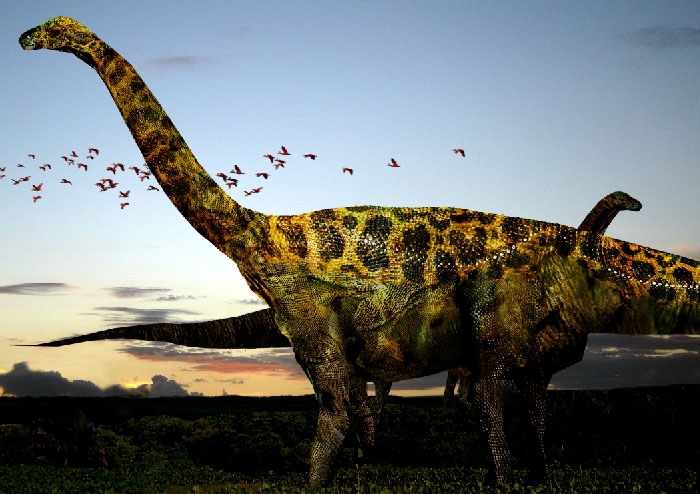

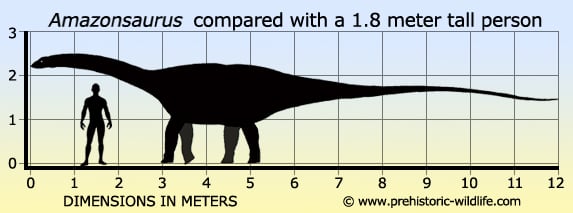
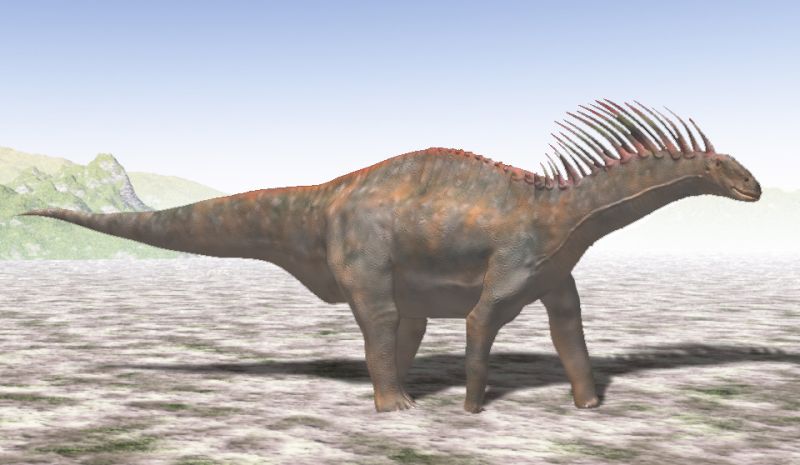








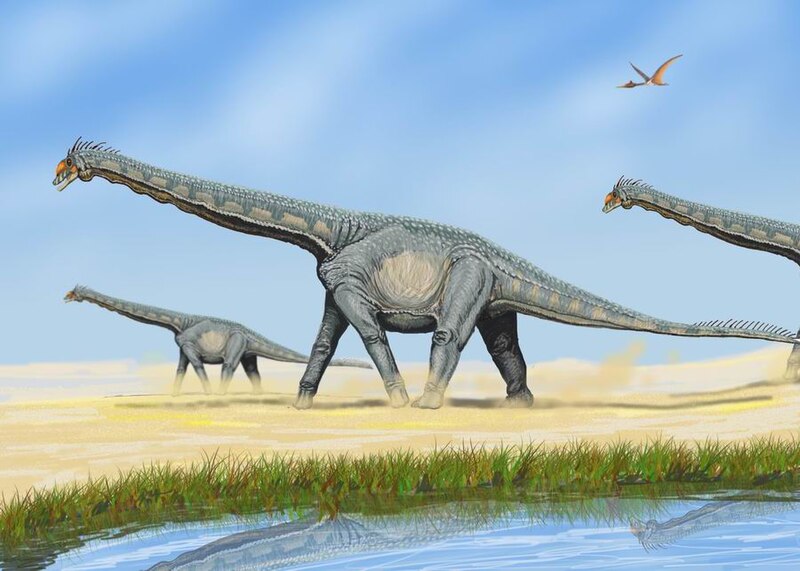








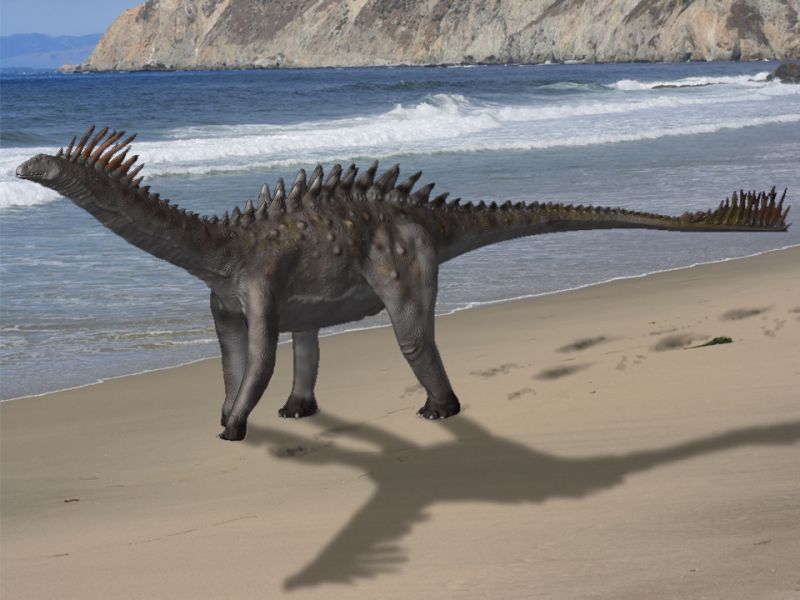


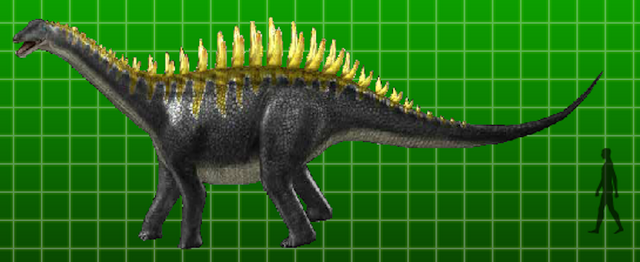



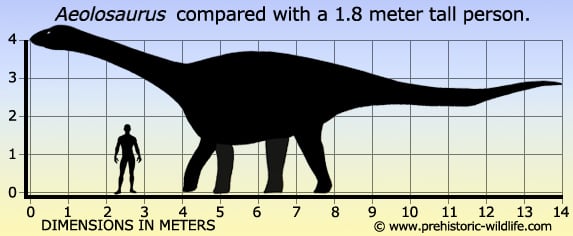



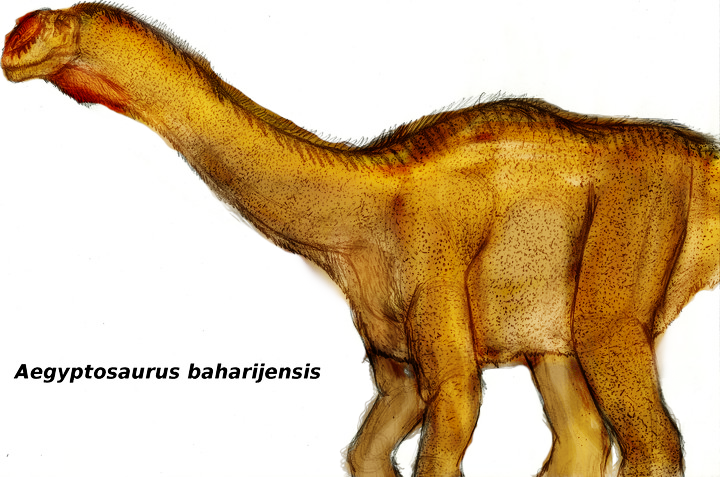


















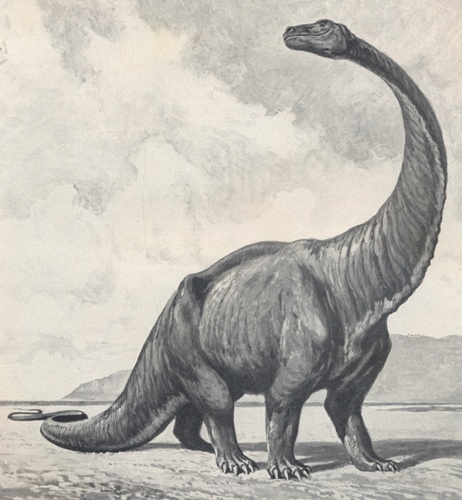


















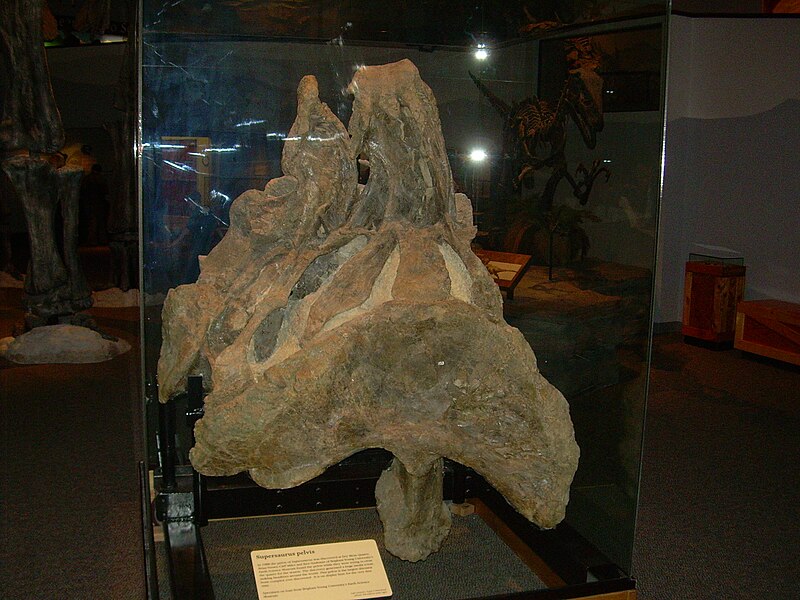



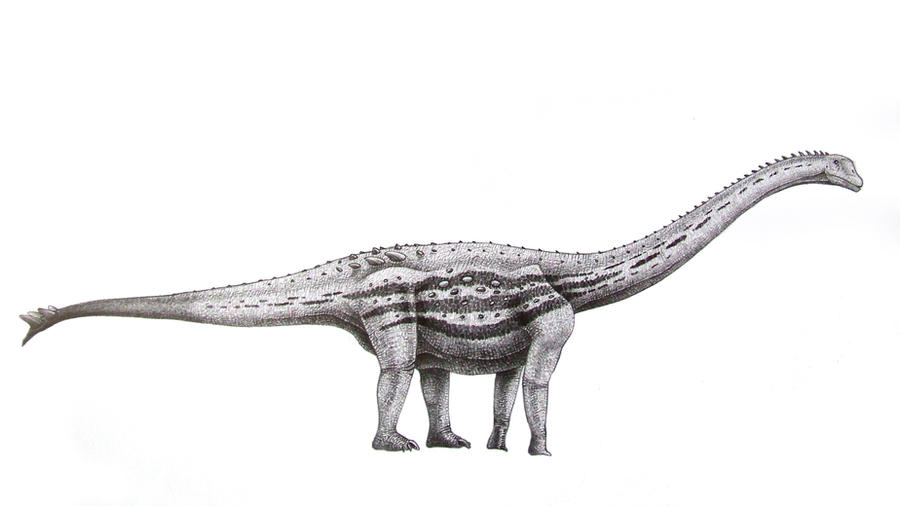














.jpg)









